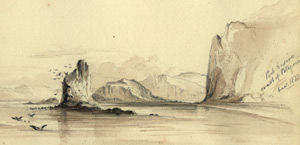Conrad Martens (1801–1878)
 |
|---|
| Port Desire, coast of Patagonia |
‘Knowing well that no one actively engaged in the surveying duties on which [we] were going to be employed, would have the time – even if he had the ability – to make much use of the pencil,’ wrote Captain FitzRoy, ‘I engaged an artist…to go out in a private capacity; though not without the sanction of the Admiralty, who authorized him to be victualled.’ Conrad Martens replaced Augustus Earle, the Beagle’s original artist, from July 1833 to July 1834, and compiled four sketchbooks (including Sketchbook I and Sketchbook III) that represent his immediate responses to scenes and landscapes encountered just before and during his time onboard. When the Beagle reached Valparaiso, he appeared to have been instructed by FitzRoy to produce a series of finished watercolours based on his pencil and watercolour sketches. Martens then travelled on to Sydney, Australia via Tahiti, Moorea and New Zealand, where he spent the rest of his life. He had retained his sketchbooks, and continued to use them as the basis for the ‘Beagle’ watercolours made in Australia thereafter. When the Beagle arrived in Australia in 1836, Darwin and FitzRoy visited Martens and both commissioned finished paintings.
James Bloxam is the conservator at Cambridge University Library who worked on the conservation of the sketchbooks. Extracts from his dissertation relating to Martens's interpretation of his mandate, and to his concept of the activity of 'sketching' can be read here.

